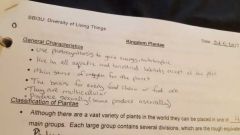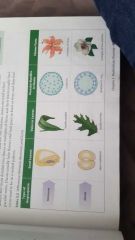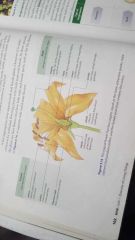![]()
![]()
![]()
Use LEFT and RIGHT arrow keys to navigate between flashcards;
Use UP and DOWN arrow keys to flip the card;
H to show hint;
A reads text to speech;
85 Cards in this Set
- Front
- Back
- 3rd side (hint)
|
What do plants have that algae don't? |
leaves, roots, stems, water-conducting materials |
|
|
|
scientists debate whether algae is in which 2 kingdoms? |
kingdom protista or plantae |
|
|
|
how long has algae been on earth?? |
2 billion years |
a long time |
|
|
algae are classified into how many types of phyla? and based on what? |
6 types and based on type of chloroplast! |
|
|
|
what are the 3 unicellular phyla? |
dinoflagellites, diatoms, euglenoids |
|
|
|
what are the 3 multicellular phylas? |
green red and brown algae |
|
|
|
which of the algae is the most plant-like? |
green algae |
|
|
|
where is green algae found? |
frwshwater and damp terrestrial places and sloth fur |
|
|
|
what do the cell walls of green algae contain? |
cellulose and store food reserves in the form of starch |
|
|
|
whats another name for brown algae? |
seaweed |
|
|
|
what are brown algae cell walls made of? |
cellulose and alginic acid |
|
|
|
where do brown algae usually live? how? |
underwater. use holdfasts to anchor algae to rocky shoreline |
|
|
|
where is red algae usually found? |
warmer seawater and are able to live at deeper depths |
|
|
|
are red and brown algae single or multicellular |
red is multicellular brown is almost always multicellular |
|
|
|
how are red algae diff. than brown algae |
more delicate and smaller |
|
|
|
why are red algae red? |
contain pigments that absorbs green violet and blue light. |
|
|
|
what is the hypothesis about green algae? whats the proof! |
that they are the closest evolutionary relatives of land plants. • presence of chlorophyll a and b • cellulose in cell walls • store food in the form of starch • simularities in genetic code |
|
|
|
when did plants evolve from aquatic to terrestrial environments? |
460 million years ago |
|
|
|
how did algae adapt to life on land? |
reproduced using embryos developed vascular tissues seeds and flowers |
|
|
|
how did vascular tissue change the small and simple plants into cooler things? |
allowed evolution of roots which gave access to anchoring the plant down and absorbing and transporting water. which let the plants grow in drier areas |
|
|
|
why did leaves evolve? |
to increase SA of plant and allowed better exchange of gases involved in photosynthesis and light capture |
|
|
|
what are the general characteristics of kingdom plantae? |

|
|
|
|
what are the four main groups a plant can be placed in? |
non-vascular plants, seedless vascular plants, gymnosperms, angiosperms |
|
|
|
what are the 3 divisions of non-vascular plants? |
mosses, liverwarts, hormwarts |
|
|
|
how do non-vascular plants transport nutrients? |
with osmosis and diffusion |
|
|
|
where do non-vascular plants grow? |
dense mats of low tangled vegetation |
|
|
|
what do non-vascular plants have instead of roots? |
rhizomes |
|
|
|
when do seedless vascular plants originate? |
about 300 million years ago |
|
|
|
what did vascular tissue do for the plants |
allowed them to grow tall |
|
|
|
where are horsetails found? |
in damp areas or along roadsides |
|
|
|
what can horsetails be made into? |
shampoo to fight headlice |
|
|
|
whats the most successful of the seedless vascular plants |
ferns |
|
|
|
whats the diff. between gymnosperms and angiosperms? |
gymnosperms have needles and angiosperms have leaves. gymnosperms have exposed seeds on the surface of the cone scales while angiosperms have them protected in a fruit body |
|
|
|
how do gymnosperms and angiosperms reproduce? |
sexually. gymnosperms don't use water and angiosperms use pollination |
|
|
|
why are conifers in triangle shaped? |
for snow to slide off |
|
|
|
what are bryophytes and how are they diff. from other groups of plants? |
they're non-vascular. they don't have roots and rely on osmosis |
|
|
|
explain the statement "bryophytes are the pioneers that conquered land" |
they converted the barren land into a lush green landscapes |
|
|
|
what are the 2 life cycle generations of a bryophyte? |
gametophyte and sporophyte |
|
|
|
how are bryophytes helpful for the environment? |
help reduce soil erosion, nutrient recycling |
|
|
|
what are the characteristics of seedless vascular plants? |
have vascular tissue, no seeds, moist enviorment |
|
|
|
what are some examples of organisms in kingdom fungi? |
mushrooms toadstools mildews yeast moulds |
|
|
|
are fungi mostly uni or multicellular |
multicellular |
|
|
|
fungi kingdom looks simular to ___ but are more like ___ |
plants animals |
|
|
|
what are the 4 ways fungi get nutrition? whats the majority way? |
parasitic, predatory, mutualistic, saprobial. saprobial is pop. |
|
|
|
what are digestive enzymes? |
are released and break down large organic molecules into smaller organic ones. |
|
|
|
what are the diseases fungi can give ya |
althletes foot and ringworm |
|
|
|
whats the simplest asexual way for fungi to reproduce? |
fragmentation |
|
|
|
how many spires can a puffball produce ? |
a trillion |
|
|
|
what are the original ancestors to fungi |
unknown |
|
|
|
what are the 5 subgroups in the fungi kingdom and which one if them is the only one to reproduce sexually? |
imperfect, chytrids, zygospore fungi, sac fungi and club fungi (sexually) |
|
|
|
whats so special about lichen |
composite organism |
|
|
|
what are the ways animals are classified? |
levels of organization symmetry and body planes body cavities segmentation movement reproduction analyze the risks posed to biodiversity |
|
|
|
what are the shared characteristics of animals |
- multicellular - eukaryotic - heterotrophic - have nervous and muscle tissue - mostly sexual reproduction - mostly mobile |
|
|
|
what are the general characteristics of animals |
eukaryotic heterotrophic require oxygen for cellular respiration all evolved from common ancestor |
|
|
|
what is homologies |
shared characteristics |
|
|
|
what are the 3 forms of symmetry. explain em |
asymmetrical- no symmetry radical- symmetrical along any planes through central axis bilateral- single line of symmetry with left/right sides |
|
|
|
cells that work together for the same function form a ___ |
tissue |
|
|
|
tissues that work together for the same function form an ___ |
organ |
|
|
|
organs that work together for the same function form an ___ ___ |
organ system |
|
|
|
what are the 3 body layers and what they include |
ectoderm- skin and nerve tissue mesoderm- muscle and blood endoderm- lungs and liver |
|
|
|
what's invertabrate mean |
do not possess a dorsal nerve cord or spine of any sort |
|
|
|
what does the phylum parifera mean |
pore bearing |
|
|
|
whats phylum platyheminthes mean |
flat worms |
|
|
|
what does phylum annelida mean |
segmented worms |
|
|
|
what does the phylum cnidaria possess |
stinging cells |
|
|
|
whats the phylum antropoda mean |
jointed feet |
|
|
|
what are the 4 classes of arthropods? |
class Arachnidia class Crustacea class Merostoma class Myriapoda |
|
|
|
what does Phylum Mollusca mean |
thin shelled |
|
|
|
what are the 3 classes of molluscs? and what's in them |
Class Cephalopodia (octopus, squid) Class Bilalvia (clams, mussels, oysters) Class Gastropoda (snails and slugs) |
|
|
|
What's the phylum Echinoderkata mean |
spiny skin |
|
|
|
compare external vs internal fertilization. |
internal occurs inside female. external occurs outside female |
|
|
|
how do sponges differ from other animals |
symmetrical body and no tissue |
|
|
|
chordata include,,, |
fish amphibians reptiles birds mammels |
|
|
|
name 5 of the general characteristics of animals |
- vertebrates - internal skeleton - gills or lungs - ventral heart - closed circulatory system - multilayered skin -have hair, feathers, claws, horns |
|
|
|
what is Agnantha and whats is contain? |
without a jaw. includes big scary fast fish |
|
|
|
Whats gnathostomata? and what classes do they contain???? |
phylum that contains jaws. Classes are class Chondrichthyes, Osteichthyes, Amphibia, Reptilia, Aves, Mammalia |
|
|
|
what are the 3 groups in the class Mammalia and what's in them |
monotrems (lays eggs) Marsupials ( pouched animals) Placental mammels (humans) |
|
|
|
what is mycelium and where is it found? |
a complex net like mass made up of branching hyphae. Found in soil and other nutritious substances. |
|
|
|
define embryo and how its associated with green plants |
an organisms prebirth stage of development. plants reproduce using them |
|
|
|
what are the 5 current threats to all living organisms |
habitat destruction invasive species illegal trade pollution climate change |
|
|
|
What are some of the impacts of climate change on aquatic ecosystems? |
male to female ratio changed fish need more oxygen appetite and feeding patterns changed |
|
|
|
which is the male reproductive part vs female - Archegonia - antheridia |
female male |
|
|
|
whats the dom. lifecycle in ferns? |
sporophyte |
|
|
|
whats the diff. between monocots and dicots |

|
|
|
|
label the flower diagram on pg 102 |

|
|

